§ 2 Interpolation formula
1. The
unequal distance node interpolation formula ( difference quotient interpolation polynomial )
The n+ 1 nodes of the known univariate function f(x) and their corresponding function values are for the interpolation interval![]()
![]()
![]()
![]()
At any point x , the function value f(x) can be calculated by the following difference quotient interpolation polynomial :

where are the first-order difference quotient, the second-order difference quotient, ... , the n -order difference quotient, respectively. Calculations can be performed column by column from left to right as follows:![]()
![]()
|
|
|
first order difference quotient |
second order difference quotient |
third order difference quotient |
… |
n -order difference quotient |
|
|
|
|
|
|
… |
|
The first order difference quotient in the table
![]()
![]()
second order difference quotient
![]()
![]()
third order difference quotient
![]()
![]()
………………………………
n -order difference quotient
![]()
![]()
Remainder in Difference Quotient Interpolating Polynomial
![]()
![]()
The remainder can also be written as
![]()
The n+ 1 order difference quotient expressed in the formula . It is convenient to use such remainders for some values of the function given by the measurement or for functions whose analytical expressions are more complex.![]()
![]()
The difference quotient interpolation polynomial clearly satisfies
![]()
![]()
The specific interpolation calculation steps are as follows :
First , calculate the difference quotient of each order by the difference quotient table, and then calculate a point a in the given interpolation interval , then![]()
![]()
![]()

2.
Isometric node interpolation formula ( difference formula )
[ Forward difference and backward difference ]
Known function f(x) at equidistant nodes
![]()
![]()
value of
![]()
![]()
The difference is calculated as follows
first order difference
![]()
![]()
second order difference
![]()
![]()
……………………
k -order difference ![]()
![]()
The symbol is called forward difference. In addition, symbols can be introduced , which are defined as![]()
![]()
![]()
![]()
The symbol is called backward differencing.![]()
The relationship between forward difference and backward difference is
![]()
[ Difference table ]
|
x |
y |
|
|
|
|
|
|
|
|
|
|
|
|
B
|
[ Newton's first interpolation formula ( Newton's forward interpolation formula )]
node is the step size) ![]()
![]()
Interpolation point ( 0 < u< 1 ) ![]()
Interpolation formula ![]()
![]()
remainder _ ![]()
![]()
where is the binomial coefficient.![]()
The applicable range is usually used to calculate the function value near the start point of the interpolation interval . ![]()
[ Newton's second interpolation formula ( Newton's backward interpolation formula )]
Node ( h > 0)
![]()
interpolation point ![]()
Interpolation formula ![]()
![]()
remainder _
![]()
![]()
in the formula
![]()
When using backward differential
![]()
Scope is typically used to compute function values near the endpoints of an interpolated interval . ![]()
[ Sterling interpolation formula ]
node
![]()
![]()
interpolation point ![]()
Interpolation formula ![]()
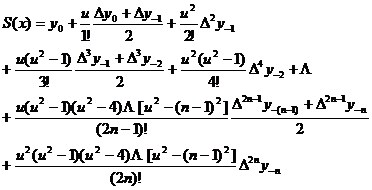
remainder _
![]()
![]()
Scope is typically used to compute function values around the midpoint of an interpolated interval. generally when
![]()
use this formula.
Note that the number of nodes used each time is an odd number.
[ Bezier interpolation formula ]
node ![]()
![]()
interpolation point ![]()
Interpolation formula ![]()





remainder _
![]()
![]()
The applicable range is usually used to calculate the function value near the midpoint between two adjacent nodes. This formula is generally used when . ![]()
Precautions The number of nodes used each time is an even number.
At the time , the interpolation formula was particularly simple :![]()

![]()
It shows that when the difference method is used for interpolation, it is not that the more items the more accurate the result, the more accurate the result is. It is not difficult to see that the linear interpolation method is only a special case of the difference method ( taking the first-order difference ) .
3. Lagrangian Interpolation Polynomial
[ Lagrangian interpolation formula ] Given n+ 1 nodes of a univariate function and their corresponding function values , for any point x in the interpolation interval, the following Lagrangian interpolation polynomial can be used to calculate the function value:![]()
![]()
![]()
![]()
![]()
here ![]()
![]()
Especially for equidistant nodes , we have![]()
![]()
![]()
![]()
![]()
in the formula
![]()
[ Etkin step-by-step calculation method ] Knowing that, to find the value
of the Lagrangian polynomial at any point a in the interpolation interval, the calculation can be performed column by column from left to right according to the following table.![]()
![]()
|
|
|
|
|
|
|
… |
|
|
|
|
|
|
|
|
|
… |
|
|
The table represents the first-order interpolation polynomial used as a node; the first-order interpolation polynomial for the node is; the k -order interpolation polynomial for the node is generally represented . Each column after the fourth column from the left in the table is the value of the corresponding interpolation polynomial at point a , and there is the following relationship between them :![]()
![]()
![]()
![]()
![]()
![]()

![]()

![]()
……………………………………………………

When using Lagrangian interpolation polynomial to calculate the value of a certain point a , each additional node must be recalculated according to the formula, and the Etkin step-by-step calculation method avoids this shortcoming.
Four cubic spline ( Spline ) interpolation formula
A spline function is a method of approximating a function.
[ Cubic spline function ] Known n points on the plane , these points are called type-valued points, which are called nodes.![]()
![]()
![]()
If the function S(x) satisfies the following three conditions :
( i ) ;![]()
( ii ) S(x) is a cubic polynomial in each interval ;![]()
( iii ) S(x) has continuous first and second derivatives over the entire interval ;![]()
Then S(x) is called a cubic spline function through n points.
A cubic spline function S(x) exists and is unique if the function S(x) satisfies any of the following boundary conditions ( additional conditions at both ends ) :![]()
( a )
The first derivative ( one-sided derivative ) of the function at both ends of the interval is known, that is, the sum is a known number.![]()
![]()
![]()
![]()
( b )
The second derivative of the function at both ends of the interval is zero, ie .![]()
![]()
( c )
The function is periodic and satisfies .![]()
[ Expression form of cubic spline function ]
![]() The form S(x) with the second derivative as a parameter is expressed over each interval as
The form S(x) with the second derivative as a parameter is expressed over each interval as ![]()
![]()
![]()
where is the undetermined parameter, but is the first-order difference quotient of , and is the first-order difference quotient, that is![]()
![]()
![]()
![]()
![]()
![]()
![]()
![]()
![]()
The function S(x) thus defined satisfies the conditions (i) , (ii) on the interval . If the choice is made such that S(x) has a first-order continuous derivative on , then S(x) has a second-order continuous derivative on , and![]()
![]()
![]()
![]()
![]()
![]()
Using the continuity and boundary conditions of the first derivative of S(x), a certain set of algebraic equations can be given.![]()
![]()
(1) The case where the boundary condition is ( a )
Under condition ( a ) , the following equations are solved![]()
![]()

where is the first-order difference quotient ( same as before ) , and the sum is the given boundary condition.![]()
![]()
![]()
Represented by a matrix
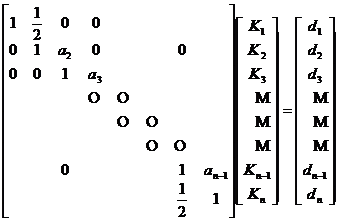
in the formula

![]()
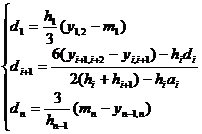
![]()
At that time , the solution was![]()
![]()
![]()
![]()

(2) The case where the boundary condition is ( b )
Under condition ( b ) , it is solved by the following system of equations:![]()
![]()
![]()
Represented by a matrix
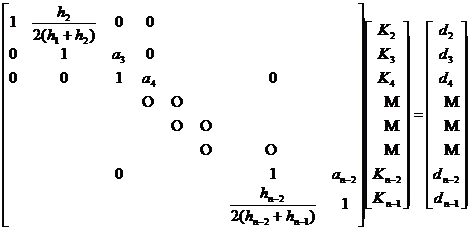
in the formula

![]()

![]()
At that time , the solution was![]()
![]()
![]()
![]()

![]()
![]() The form S(x) with the first derivative as a parameter is expressed over each interval as
The form S(x) with the first derivative as a parameter is expressed over each interval as![]()
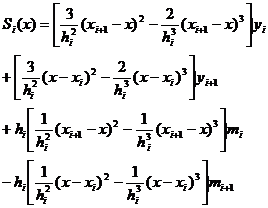
where is the parameter to be determined. The function S(x) defined in this way satisfies the conditions ( i ) and ( ii ) of the cubic spline function on the interval , and S(x) has a continuous first-order derivative on the interval, and at the same time![]()
![]()
![]()
![]()
![]()
![]() Sometimes it is expressed as:
Sometimes it is expressed as:
![]()
in the formula , and the same as the definition before.![]()
![]()
![]()
A definite system of algebraic equations can be given according to the continuous second-order derivatives and boundary conditions on .![]()
![]()
![]()
(1)
The case where the boundary condition is![]()
Under the conditions , the following equations are satisfied![]()
![]()

![]()
remember , gotta![]()

![]()
It can be rewritten as

![]()
in
![]()
![]()
![]()
![]()
![]()
From this we get
![]()
![]()

![]()
( 2 ) the case where the boundary condition is ( b )
Under condition ( b ) , the following equations are satisfied![]()

![]()
where is the first-order difference quotient.![]()
![]()
when and when ,![]()
![]()
![]()

![]()
where , while recursively obtained by the following formula![]()
![]()
![]()
![]()
![]()
![]()
![]()
![]()
( 3 ) The case where the boundary condition is ( c )
Under condition ( c ) , the following equations are satisfied :![]()
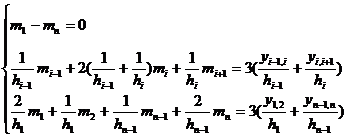
![]()
5. Other interpolation formulas
[ Univariate three-point interpolation formula ] Knowing the value of the univariate function y=f(x) on n nodes , for any point x in the interpolation interval, the function value can be approximately calculated according to the following formula![]()
![]()
![]()
![]()

where are the three known nodes closest to x .![]()
[ Binary interpolation formula ] It is known that the node of the first independent variable of the bivariate function is , the node of the second independent variable is , and the function value on the corresponding node is . Then for the argument value that is not a node, the function value can be approximated by the following formula![]()
![]()
![]()
![]()
![]()
![]()
![]()
 ( 1 )
( 1 )
 ( 2 )
( 2 )
( 2 ) are the three nodes where the first argument is closest to x , and are the three nodes where the second argument is closest to y .![]()
![]()
[ Hermitian Interpolation Formula with Derivative ] Knowing that the value of the function y=f(x) and its derivative at n nodes is and , then for any point x in the interpolation interval, the function value can be calculated as follows![]()
![]()
![]()
![]()
![]()
![]()
![]()
in the formula


remainder
![]()
where is a point in an interval [ a, b ] that contains all nodes .![]()
![]()
It is easy to know that in the formula is a polynomial whose degree does not exceed and satisfies .![]()
![]()
![]()
![]()
![]()